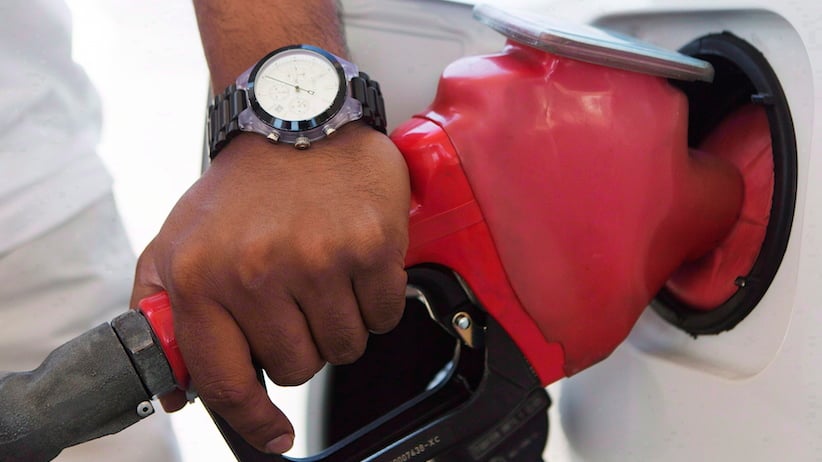Cheap gas prices fuel conundrum in Detroit
Low gas prices mean consumers want bigger, more powerful vehicles, even as tough fuel economy rules force the industry to think small
A gas price of $1.94 per gallon for regular gas is shown at a gas station Wednesday, Dec. 31, 2014, in Cleveland. The average cost of gas in Ohio has dipped below $2 per gallon for the first time in more than five years. The average for a gallon of regular gas fell to $1.99 in Wednesday’s survey from auto club AAA, the Oil Price Information Service and WEX Inc. Ohio AAA spokeswoman Kimberly Schwind said that average hasn’t been below $2 since April 28, 2009, when it was $1.98. She says back then, the recession was a key factor. (AP Photo/Tony Dejak)
Share

The mood at this year’s Detroit auto show was equal parts jubilant and confused. Automakers are no doubt thrilled consumers are flocking back to showrooms, as the U.S. economy gains traction and gas prices fall to their lowest level in six years. But with oil now below US$50 a barrel, the industry faces a conundrum with its product lines: Consumers want big and powerful, while regulators demand small and fuel-efficient.
The U.S. government’s new fuel-economy standards call for automakers’ portfolios to average 54.5 miles per gallon by 2025 and an increase to a 34.5-mpg average by 2016, although cars and light trucks have different targets. To get there, carmakers need to sell far more fuel-sipping conventional small cars, gas-electric hybrids and plug-in electric vehicles than they do today. However, as gas prices fall, Americans, in particular, are rediscovering their love of larger and roomier vehicles. They bought nearly one million more light trucks and SUVs last year than they did cars, reversing a trend toward cars that began earlier in the decade. That’s going to make it tough—some say impossible—for automakers to hit those aggressive new fuel-economy targets.
In Detroit, the challenge of serving two very different masters was on display everywhere. Ford Motor Co. spent most of its time flogging big, powerful vehicles such as its new Mustang, with more than 500 horsepower, and a GT supercar concept with more than 600 hp. Chrysler, too, was turning heads with its previously announced 704 hp Dodge Charger Hellcat sedan, which is marketed as the first daily driver that will make track enthusiasts blush. And both Toyota and Nissan used the annual show to launch new pickup trucks—the Tacoma and Titan, respectively.
Meanwhile, on the other side of Detroit’s Cobo Center, General Motors kicked things off by unveiling a redesigned version of its Volt electric car that’s backed up by a conventional gas engine, and by taking the wraps off a new all-electric Bolt concept, which is supposed to travel 320 km on a single charge and cost just US$30,000. It was probably no coincidence that a Michigan senator was in attendance for the unveiling.
Dennis DesRosiers, a Canadian auto industry analyst, called this year’s show “schizophrenic” and warned that the competing trends—tougher U.S. fuel regulations and consumer appetite for bigger vehicles—were on a collision course. “The politicians don’t understand that the consumer has the biggest role, when it comes to fuel efficiency,” he says. “But the vehicle companies are the ones who pay fines if they don’t meet fuel-efficiency regulations.”
While it’s possible for automakers to build both the bigger vehicles that consumers want and meet tough fuel-economy standards, Sergio Marchionne, the CEO of Fiat Chrysler Automobiles, warned that the resulting vehicles are going to be a lot more expensive, possibly dulling their appeal. “We don’t look at oil now,” Marchionne says of the decision-making that goes into developing new vehicles and drive trains. “We look to C02 (emissions), which is a good thing—painful, but good.”
For example, Ford re-launched its bestselling F-150 pickup at last year’s show with a new, lighter aluminum construction—a change that not only requires more expensive materials but a significant re-tooling of its manufacturing process and supply chain. Others have invested heavily in alternative power train systems such as hybrids, electric and fuel-cell vehicles.
There is already speculation that U.S. automakers, who have historically specialized in building larger vehicles, will ask for relief from regulators in advance of a review of the mileage regulations in 2017. However, DesRosiers says that could end up penalizing foreign carmakers that are more car-focused.
The issue is less pronounced in Canada, because consumers here tend to buy smaller, more practical vehicles than their American counterparts. In the case of Toyota, vice-president of sales, Larry Hutchinson, argues that the automaker would have made investments in cleaner-burning technologies anyway, because that’s where it believes the industry is ultimately heading. “In the long term, gas is going to get more expensive and you also have the regulations,” he says, adding that Toyota embarked on hybrid vehicles such as the Prius in the late 1990s, long before tougher U.S. fuel-economy standards were announced. “Our position is to offer innovation and fuel-economy leadership.”
Even so, without politically unpopular efforts to change consumer behaviour—such as steeper gas taxes—automakers will be forced to spend millions building what they can’t sell. And that’s unlikely to make anyone happy.